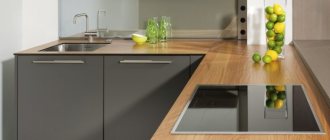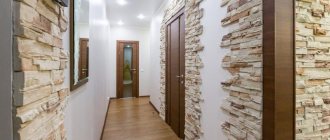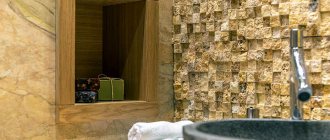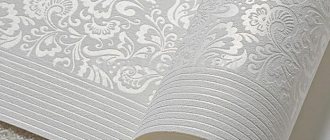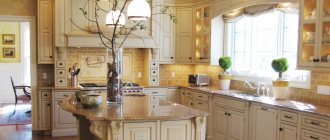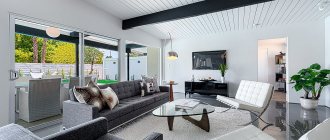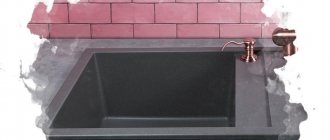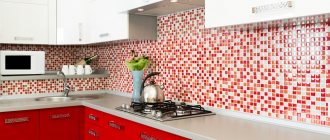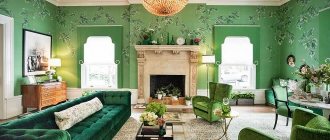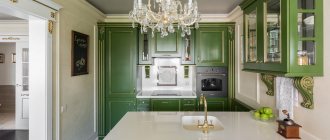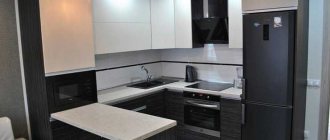Advantages of finishing
A stone wall in the kitchen has a number of advantages, including durability and strength; there is no need to make frequent cosmetic repairs. In addition, it is an environmentally friendly and easy-to-install material on the wall that requires minimal maintenance and is available in a wide selection of designs and types.
Decorative stone for the wall can be purchased in the desired size and at an affordable price, which will not burden the wall surface.
Tips and ideas for decorating a kitchen with artificial stone
If you follow the recommendations of professionals, you can create exclusive designs in your kitchens. To visually increase the space, lay the decorative stone horizontally. And for decorating dining areas, you should choose delicate and soft colors.
In conclusion, I would like to add that decorative stone in the kitchen interior looks extremely aesthetically pleasing. It captivates with its unique structure, interesting texture and color variations. Due to the ease of installation, decorative stone is widely used in modern kitchens. It is able to hide minor defects and imperfections of surfaces, create an original ornament, and make the room unique and inimitable. Use decorative stone in your kitchens and enjoy its ease of use, aesthetic appearance and durability.
Artificial and wild stone
Artificial (decorative) stone
It differs little in appearance from the natural one, repeating its shape, texture and size. It weighs less than natural material and is made from sand and cement.
From a practical point of view, artificial is not inferior to natural, it can be made in any color, and you can decorate the kitchen in different ways. It easily adheres to the surface, is impact-resistant and wear-resistant.
Wild (natural) stone
It is distinguished by its unique origin and unique exclusivity. Natural masonry carries the energy of naturalness, which fills the kitchen with comfort. Durable, does not require special care, shock-resistant, tolerates changes in moisture and temperature.
The photo shows an eco-style kitchen with natural stone on the wall, which is illuminated by spots to create a cozy atmosphere.
Advantages of decorative stone
Decorative stone is considered a popular building material when finishing kitchens. This material amazes consumers with its aesthetic appearance and good technical characteristics. Decorative stone has a lot of advantages, namely:
- wide range of textures and colors;
- long service life;
- resistance to negative factors;
- resistance to mechanical damage;
- strength and reliability;
- environmental friendliness and safety.
Highlight the kitchen area with finishing stone with the texture of coarse sandstone
Decorative stone finishing of a kitchen stove in the style of an antique stove
It's easy and simple to work with. It is sawed and drilled with various available tools.
Designers recommend using decorative stone in the Provence and country directions. And also in medieval style.
Finishing the kitchen apron in Provence style with decorative stone
The stone is well suited for the background decoration of country style kitchen walls
Walls decorated with large cobblestones fit perfectly into the rustic style
Finishing a kitchen wall with decorative stone in a loft style
Decorative stone does not like bright lighting. Therefore, it is recommended to have dim lighting. If the material is used to decorate the work surface or apron, there should be a lot of light in this area.
Soft, subdued light gives the decorative stone a warm tint
Designers love to combine decorative stone with natural greenery. To emphasize the individuality and originality of the kitchen, place hanging flowers.
Flowers and greenery will enliven the kitchen interior when finishing with decorative stone
Also, decorative stone is in harmony with rough cobblestones in the interior, wicker furniture and aluminum.
Important! For small rooms, you should choose small artificial stone tiles. Since large elements will overload the room.
Dilute decorative stone with softer finishing building materials, such as wallpaper, decorative plaster and other decorative elements.
Light finishing stone goes well with decorative plaster
A single column trimmed with stone against a background of dim wallpaper
Types of natural stone
Marble
It is distinguished by colored veins and is not resistant to kitchen cleaning chemicals. It is better to cover a marble apron or a wall near the sink with a protective layer.
Granite
Granite is equally durable and comes in different shades depending on the place of origin. Tolerates high temperature, moisture, shock.
Travertine
It withstands mechanical stress well, but does not tolerate contact with chemical acidic kitchen cleaning products. Usually gray or white.
Dolomite
It comes in white to brown color, it is used to line stoves, it is heat resistant, and its parameters are similar to granite.
Slate
It comes in yellow, brown, burgundy, green and multi-colored varieties. Thin thickness and smooth surface is suitable for layering.
The photo shows a slate wall in a modern kitchen, which is easy to clean and has a high service life guarantee.
Sandstone
It is a porous rock, its hardness depends on the bonding limestone or quartzite. Used for wall cladding.
Onyx
Shimmers in light and dark layers. Durable, decoratively attractive for wall decoration in the kitchen.
Pebbles
River or rock pebbles of different colors require cleaning to prevent mold from appearing in the spaces between the stones, if this is a kitchen surface with high humidity, or an apron.
The photo shows a black pebble work surface, which is evenly sunk into cement and sanded to a smooth surface for easy cleaning.
Finishing a kitchen apron with stone
Another example of the practical use of stonework is the design of a kitchen apron made of stone. Stone, especially natural stone, is excellent for finishing a protective sheet.
The material is durable, has a pleasant and very original design, and is resistant to moisture, temperature changes and aggressive detergent components. Just like a classic tiled splashback, this covering can be supplemented with lighting fixtures, storage systems, and decorative elements.
Stone and brickwork
Under the stone
It has many varieties, including cladding, installing stones on a flat surface with an adhesive mixture.
A flat view of the kitchen wall is laid with a die, and it is necessary to select and lay it so that there are no obvious voids. Volumetric masonry made of thin stone can be laid smoothly or in relief.
Under the brick
Stone in the kitchen can be laid using American, English, or Flemish bonding.
In the photo, the wall in the work area is lined with granite and highlighted with a niche made of brickwork to resemble a rustic stove.
The “Castle” cladding imitates the masonry of a medieval fortification. A rectangular identical stone is laid according to the “Shahriar” type.
The photo shows brickwork in a modern-style kitchen, where brick performs not only a decorative, but also a practical function.
Stone in various interior styles
Imitation of brickwork on the kitchen apron in a neoclassical style
Country and Provence
These styles are dominated by rustic motifs. Kitchens with such an interior create a cozy home environment.
Stone and wood are the most suitable materials for finishing a country-style kitchen
The stone is chosen to have a coarser texture with convex parts; imitation brickwork is also suitable. Shades vary depending on the style, but light colors are preferred. Provence is characterized by colors close to white: beige, cream.
Imitation of brickwork using artificial stone in a Provence style kitchen
Stone in these styles is used to decorate kitchen aprons and openings. The hood is disguised as a false fireplace or country stove. Decorative interior items and kitchen utensils will help enhance the rustic flavor.
English style
A very noble and elegant interior option. In the classic English style, expensive finishing materials are used, such as marble, mother-of-pearl, and malachite. Their combination and the work of artisans made it possible to create a harmonious and cozy environment.
In an English-style kitchen, stone is appropriate primarily on the floor and as a material for countertops
Thanks to the advent of modern artificial materials that perfectly imitate most minerals, it has become possible to recreate an English interior at a lower cost.
The working surfaces of the kitchen set are made of porcelain stoneware to match the wall decoration
Porcelain tiles are used for the floor. The apron and tabletops of furniture are made from agglomerates. The walls can be decorated with artificial savage. The design should be done in pastel colors.
Antique
This style is also called ancient Greek. Classic style with prevailing correct geometric proportions. Often, a material with the same or similar structure is used for all cladding. Lighter shades are mainly used, marble tiles predominate.
Work surfaces made of acrylic stone or porcelain stoneware look great paired with a classic set.
The interior is characterized by some elements of antiquity: columns, bas-reliefs. Antique style is used in large kitchens with the ability to make arched windows.
Modern
Art Nouveau is characterized by smooth forms and asymmetry in design. In the modern understanding of modernity, there is no excessive luxury and pretentiousness of the furnishings of the 19th century. Instead, the style gives a feeling of comfort and cheerfulness.
Snow-white kitchen in Art Nouveau style with acrylic surfaces
For modernism, a single-color stone is more suitable; acrylic is mainly used. Apply cladding to niches and openings; you can also use it for countertops.
Modern styles
Decorative stone is also used in the interior of modern styles:
- minimalism;
- loft;
- high tech.
An apron made of decorative stone will become a bright accent in a kitchen in a minimalist style
Decorating a small kitchen in loft style
High-tech requires shine and gloss, which means it is better to use acrylic stone or porcelain stoneware
A common feature of these styles is the desire for minimalism in furnishings and design. In some cases, styles are even mixed to achieve the design intent. At the same time, artificial stones are used mainly to create accent elements, such as a section of a wall in the form of masonry.
Types of stone for finishing
Piece
Piece or rectangular stone is laid separately, which allows you to create a unique pattern for wall cladding in the kitchen.
Panels
They make work easier, they are quite light when mounted on a wall, and imitate any type of stone. They come in slatted, tile, and sheet sizes up to two meters.
Gypsum stone
Lighter than concrete, treated with acrylic varnish for a long service life. Suitable for kitchen walls made of plasterboard, sold unpainted. Unstable to mechanical stress and high humidity.
Flexible stone
This is the thin top cut of the stone on the fabric. Additionally impregnated for resistance to chemical influences. Suitable for decorating arches, columns, and accent walls in the kitchen.
Plaster
Simulates masonry by creating a relief texture and natural colors, extruding joints. Plaster can create a flat wall that looks like marble or honed stone. Also, the plaster can be flat-relief, convex, imitating textured masonry on the kitchen wall.
The photo shows the wall being finished with plaster with an imitation of a solid stone layer in section. The pink interior is combined with the beige background of the apron.
Finishing features
When laying stone with your own hands, try to remember a few basic rules that can be used both during installation and when choosing material.
- Observe the dimensions of the material and the dimensions of the room. Large stones will look out of place in a small kitchen, and, conversely, small stones will “blur” in a spacious room.
- Decorative stone perfectly protects walls, so place it in the most “fragile” places, for example, near the front door, next to the work surface.
- Combine the incongruous. Use different materials, creating harmony and comfort, for example: wicker items look good with uneven stones, bricks soften aluminum pipes in the interior.
- Sometimes it is enough to lay out only a narrow row of decorative stone to transform a room. Therefore, before purchasing finishing materials, think carefully about all the options (see also the article Finishing a kitchen with brick - what it looks like).
Design methods
Several walls
You can cover it with stone if the kitchen is medium to large in size. You can make adjacent or parallel walls from boulders in combination with wood or plaster.
One wall
It will attract attention; it is better to decorate a wall free of furniture with stone, for example, near the dining room group.
Part of the wall
Part of the wall can be lined with stone if it is a small kitchen. The part can be upper, lower, or combined with wallpaper.
Stone panel
Framed or edged, stone panels provide decor that can be replaced and moved.
Niches or shelves
Niches or shelves trimmed with stone do not take up much space and create a unique design.
Apron
It can be made from natural or artificial stone, the main thing is to protect it from the formation of mold and mildew due to high humidity near the sink. The stone can be flat, imitating a marble slab, brick, laying with a die is suitable.
Corners, doorways, arches
Corners, doorways or arches in the kitchen can be completely or partially covered with bricks of different sizes, thereby strengthening them.
The photo shows square columns that serve as the entrance to the kitchen, where the apron is lined with pebbles and the countertop is made of granite. The unity of different breeds is harmoniously combined in one interior.
Color palette
As for the color palette of natural or artificial finishing materials, it is truly huge. Here are the most common options:
- White. This is a natural or acquired color from dyeing.
- Color. It is possible to obtain different shades by mixing different colors into white paint.
- Colored with the application of darkened shades to individual areas.
- Shades characteristic of natural stone: gray, ivory, shades of brown, beige, sand.
Combinations with other materials
You can combine brick or stone on the wall with other finishes to create a varied kitchen interior.
Stone and wallpaper can be combined in an area where the humidity is lower and less susceptible to pollution. Wallpaper can be matched to the color of the stone or highlighted with a bright color. Photo wallpaper in a stone frame will look interesting.
Masonry with wood looks organic in any proportion of wood. This could be laminate, wood panels, cork, wood-look tiles.
The paint can be matched to the color of the stones or you can highlight them with a contrasting wall color.
A stone wall with plaster or paint is suitable for any size kitchen. Venetian plaster looks interesting in combination with flat stone.
Do-it-yourself artificial stone laying
Home craftsmen who have no experience in laying decorative stone can gain first experience when tiling a small area of the room - for example, the space around the hood, or the area of the work apron, but also for zoning the kitchen and dining room.
It is recommended to choose a textured cement material, the work with which does not require high qualifications, unlike, for example, the installation of porcelain tiles.
- To lay the stone you will need: a spatula, primer, grout, glue, roller, pencil, corner, ruler, twine;
- after all calculation operations and measurements, the main work begins;
- a primer is applied to the wall using a roller, then the surface is leveled with a wide spatula;
- after the composition has dried, the base is coated with a thin layer of special glue (all building mixtures must be chosen correctly!);
- laying begins from the bottom edge - this is necessary so that the following blocks do not budge or slide down;
- the finishing element is applied to the surface and pressed lightly;
- to ensure even gaps between stones, plastic delimiters should be used - they are sold in hardware stores;
- Installation must be carried out quickly so that the glue does not have time to dry.
The technological process will not be complicated if you prepare everything necessary in advance and follow the technologies specified by the manufacturer.
Laying decorative stone, video instructions:
Color solution
White
White (quartzite, granite, marble, brick) is suitable for Scandinavian, modern classic kitchen style, expands the space and combines with black, dark brown flooring and wood paneling.
Black
It will add charm to the kitchen, without being too easily soiled. Suitable for a spacious room or in combination with white, brown.
Grey
Gray color (slate, granite, quartzite, marble) will become the background for a bright set, combined with neutral colors.
Red
Red (brick, onyx, granite) attracts attention, is suitable for creating luxury, combined with a red countertop, dark wood.
In the photo, red brick looks organically in a modern interior along with lighting, a glossy facade and a marble floor.
Brown
Brown color accompanies almost all natural wood, combines with wood finishes, adds coziness to the kitchen, and is suitable for any style.
Beige
It is better to combine beige for wall design with dark colors of other finishes, or make it the background for a visually accent set.
Color
Colored with tints, veins, a combination of different colors (pebbles) gives a unique perception of the kitchen, a unique wall will look original and attract attention.
Why stone
The stone is appropriate in the design of a spacious kitchen; it looks no worse in a small area. The advantages of the stone, which explain its popularity among finishers, include:
- variety of color and texture possibilities;
- absence of harmful factors affecting humans, i.e. environmental friendliness;
- proven installation technologies;
- high mechanical strength and the ability to withstand negative influences during operation in conditions of elevated temperatures and humidity typical of the kitchen;
- durability.
Style selection
The variety of shapes, types of stone and color choice makes it possible to use it as a finish in any style.
Modern style
For a modern kitchen you can choose glossy stone, stone finishes (Venetian plaster), rough natural, painted gypsum stone. It is important to choose the right color that will be the background for the headset, or will become the main highlight.
The photo shows a bright kitchen with stonework in the apron area, which matches the color of the countertop and furniture.
Classic
The classic style allows for cladding only from natural expensive species in yellow, brown, and white. Flat masonry or panels made of onyx and marble will decorate the apron and wall of the dining table.
Loft
A loft is created in the kitchen using gray or red stone on the apron or on one of the walls, which borders on white, gray, black painted surfaces. The furniture and kitchen appliances must match the interior.
Eco style
Eco style involves masonry made of natural rock in combination with wood on the floor or walls. If the kitchen is small, then you can make masonry on the windowsill, part of the surface in combination with a white floor and green walls.
Chalet
The chalet involves a combination of rough wild boulders, pebbles with a bulky wooden ceiling in dark brown and gray. This style can only be created in a spacious kitchen with large windows.
Country
Country style can be created by lining the apron and part of the kitchen in the area of the hob. The countertop or floor can also be made of stone, which differs in several tones.
The photo shows a country-style kitchen, where flat laying of natural stone is combined with rough wood, wooden utensils and decor.
Positive features of stone finishing
Among the advantages of this facing material, which make it possible to use it in a kitchen, we can highlight:
- durability;
- strength;
- magnificent appearance;
- environmental friendliness;
- ease of installation;
- minimal maintenance of the finished coating.
- a wide range of textures and colors of coating;
- less weight compared to natural, which allows it not to burden the base surfaces;
- impact resistance;
- resistance to moisture and cleaning agents.
Wall decoration
The main requirement for any interior is completeness. Therefore, finishing stone can be used not only for the “apron”. Wall cladding not vertically, but in a horizontal direction allows you to make a compact kitchen-living room or Khrushchev kitchen visually wider. In this case, it is not at all necessary to cover the walls completely. Partial finishing is enough, and the rest can be plastered or painted.
Ways to decorate walls and aprons with stone in the kitchen
As already mentioned, more than one experienced designer does not recommend decorating the entire kitchen with decorative material. In this case, there is a risk of getting an impractical, busy and dull interior, which was clearly not intended in the original idea.
The main rule is that the stone must be diluted or even applied spot-on.
A few examples are presented below.
You can often find stone finishing of the entire wall of the work area. This option is practical in terms of cleaning and gives some zoning effect, which is important for studio apartments.
Finishing the kitchen work area with decorative brickwork
It is also appropriate to decorate a dining area where durable material is needed due to the increased use of this area of the house.
Decorating the kitchen dining area with decorative stone
The material does not necessarily have to be of practical use. In a combined kitchen and living room, it can simply dilute the monochromatic finishing options.
Decorative brickwork can brighten up any interior
Recently, continuous finishing of the apron and countertop (often the entire work area) has become extremely popular. But mainly granite and marble are used for this.
Some designers use techniques such as highlighting corners, decorating a bar counter, laying out shelves in large blocks, decorating columns or ventilation ducts.
Combination of finishing and kitchen units made of natural stone
